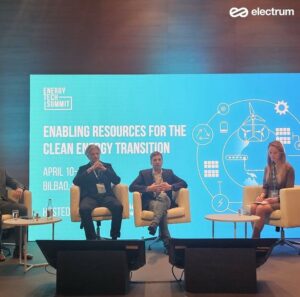Artificial Intelligence (AI) in the Energy Sector
In April of this year, during the Energy Tech Summit conference held in Bilbao, Spain, Agnieszka Gawinek spoke about artificial intelligence in the energy sector. Today’s article is based on the material prepared by the speaker.
What Awaits Us in the Future??

How can new technologies, such as artificial intelligence (AI), help achieve better results without additional investments in existing resources or infrastructure? When discussing sustainable growth, Net-Zero strategies, or energy efficiency, we should focus on creating more benefits and additional value from energy assets using innovative IT tools and a smart, long-term vision of the future.
The Neuronal Brain of the Climate Tech Energy Centre
As we all know, energy assets require dedicated services such as maintenance, constant monitoring with guaranteed SLA agreements, specialists always on standby with extensive knowledge and solutions for any emerging challenge.
Imagine for a moment a digital neuronal brain, pulsating with thousands of interconnected neurons, dealing with the analysis and innovation in the field of climate, energy, and technology… This is the core of a sustainable future where ideas transform into technologies that provide clean energy.
How Can It Work?
1) This advanced AI-based system acts as a pulsating center of thoughts and ideas. It consists of thousands of interconnected neurons and analyzes data related to climate, energy, and technology to draw conclusions and propose innovative solutions.
2) The neuronal brain collects vast amounts of data on climate change, energy consumption, renewable technologies, and other key areas. By analyzing Big Data, it generates insights and forecasts to support decision-making related to environmental protection and clean energy development.
3) Using advanced machine learning algorithms, the neuronal brain designs new technologies related to renewable energy, energy efficiency, and CO2 emission reduction.
4) It not only generates ideas but also supports startups and innovators in bringing their solutions to the market. By collaborating with experts from various fields, it mobilizes the resources needed to accelerate the transition to clean energy.
Trends in the Evolution of Energy Architecture

The future depends on integrating artificial intelligence with various energy sources and storage solutions, creating a synergy that not only ensures stable energy supply but also protects the environment. Key observed trends in the evolution of energy architecture may include:
- Greater diversification of energy generation sources.
- Increasing share of RES compared to conventional power plants.
- Dynamic changes in the energy mix, adapting to market conditions.
- Stricter requirements for energy quality and detailed energy consumption profiles.
AI in Energy and the Era of Change
We must be ready and open to the Era of Change, where traditional energy systems give way to innovative architectures based on distributed and decentralized energy sources. What does this mean? Which elements of this new energy system are crucial?
1. Distributed Energy Sources
The vision of the future relies on the use of distributed energy sources – smaller in volume but in greater numbers of locations. The combination of various renewable energy sources and microgrids moves towards a sustainable ecosystem that produces energy for local communities and industrial zones.
2. Decentralized Management Systems
Traditional centralized management systems are giving way to decentralized platforms based on blockchain and artificial intelligence. These smart grids allow for efficient management of energy production, distribution, and consumption at both local and global levels.
3. Innovative Energy Storage Technologies
Energy storage is becoming a key element of the future energy architecture. From advanced batteries to technologies based on hydrogen and other energy carriers, innovative solutions allow for the flexible and efficient storage and use of energy.
4. Interactive Networks and Social Collaboration
In the world of the future, everyone can be both a producer and a consumer of energy. Interactive networks and social platforms enable energy exchange between users, supporting the idea of resource sharing and energy solidarity.
5. Sustainable Development and the Environment

The new energy system architecture emphasizes sustainable development and environmental protection. Transitioning to renewable energy sources and reducing CO2 emissions become key priorities to create a clean and healthy planet for future generations.
Climate Tech and AI Features in the Energy Sector
Artificial intelligence is an essential component of Climate Tech.
Intelligent Management
Artificial intelligence enables the optimization of energy production, distribution, and consumption in real-time, using data to forecast and adjust.
Dynamic Response to Changing Conditions
Thanks to artificial intelligence, the system can dynamically respond to changing environmental, political, and economic conditions. Flexibility allows for quick adaptation to new situations and minimizes risks associated with conflicts or climate changes.
Optimizing Resource Use in Different Regions and Times
Artificial intelligence in the energy sector enables the optimization of the performance of existing wind, photovoltaic, or hybrid power plants, even if they are not designed and built in the best way.
We Offer Creative Technological and Business Solutions at Every Stage of Investment::
Learn more about Who We Are – Electrum Holding
Market and Policy Adaptation
Artificial intelligence combined with human intelligence brings fantastic results in the business area. The world of energy is changing, regardless of which country we consider. Each one is in the process of energy transformation. Therefore, systems must be flexible and adapt to emerging business opportunities.
Technology Development
It is clear that energy systems will be improved every year. We have limited natural resources and time to save the planet and the environment. Hence, our mission is to invent highly advanced and prosperous solutions needed to ensure overall global growth.
Machine Learning and Energy Production
Machine learning plays a key role in predicting demand and production levels, allowing for the optimization of energy use by adjusting resources during peak hours.
Optimized Distribution
Intelligent systems take into account various factors such as costs and emissions to effectively control energy distribution, ultimately minimizing losses.
Dynamic Pricing
Dynamic energy prices change depending on demand and supply, leading to increased economic efficiency. Both consumers and producers benefit from it.
Achieving Network Harmony
Network harmony can be achieved when production and consumption are at the same level.
Improved Weather Forecasting Models
Using AI technology for better prediction of weather changes. This can be one of the key factors in effectively managing electricity production and distribution.
Artificial Intelligence in the Energy Sector – Summary
The Energy Tech Summit 2024 conference proved to be extremely fruitful for us. We had many inspiring conversations about the future of the energy sector, the role of companies in shaping a sustainable sector, and the revolutionary technologies that await us just around the corner.





